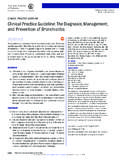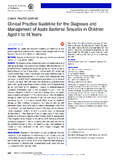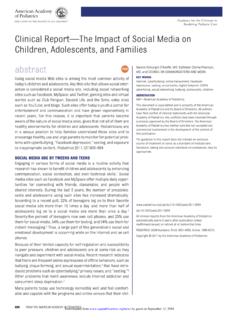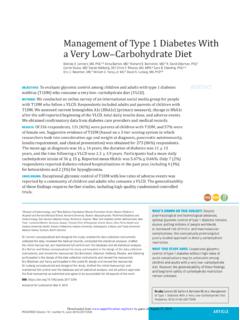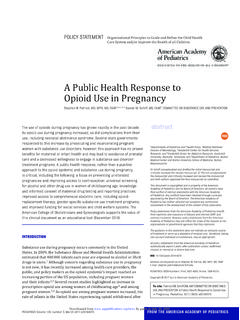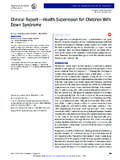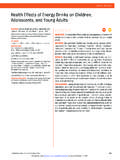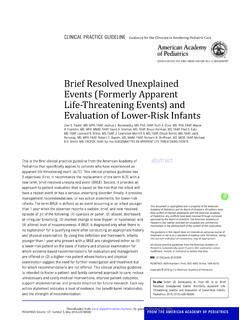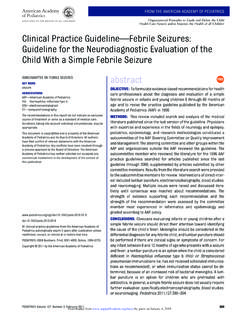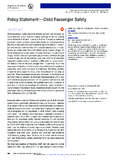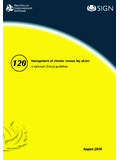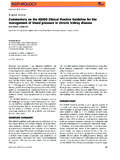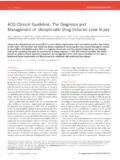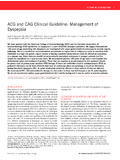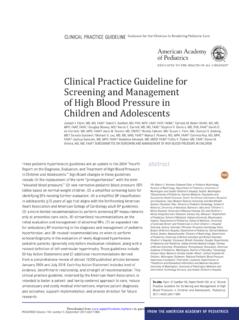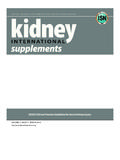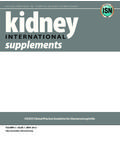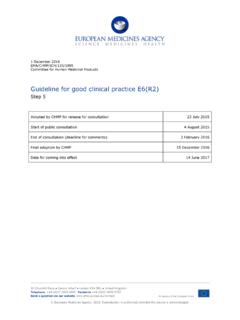Transcription of CLINICAL PRACTICE GUIDELINE ClinicalPracticeGuideline ...
1 Guidance for the Clinician in Rendering Pediatric Care CLINICAL PRACTICE GUIDELINE . CLINICAL PRACTICE GUIDELINE : The Diagnosis, management , and Prevention of Bronchiolitis abstract Shawn L. Ralston, MD, FAAP, Allan S. Lieberthal, MD, FAAP, H. Cody Meissner, MD, FAAP, Brian K. Alverson, MD, FAAP, Jill E. Baley, MD, FAAP, Anne M. Gadomski, MD, MPH, FAAP, This GUIDELINE is a revision of the CLINICAL PRACTICE GUIDELINE , Diagnosis David W. Johnson, MD, FAAP, Michael J. Light, MD, FAAP, and management of Bronchiolitis, published by the American Academy Nizar F. Maraqa, MD, FAAP, Eneida A. Mendonca, MD, PhD, of Pediatrics in 2006. The GUIDELINE applies to children from 1 through FAAP, FACMI, Kieran J. Phelan, MD, MSc, Joseph J.
2 Zorc, MD, 23 months of age. Other exclusions are noted. Each key action state- MSCE, FAAP, Danette Stanko-Lopp, MA, MPH, Mark A. ment indicates level of evidence, bene t-harm relationship, and level Brown, MD, Ian Nathanson, MD, FAAP, Elizabeth of recommendation. Key action statements are as follows: Pediatrics Rosenblum, MD, Stephen Sayles III, MD, FACEP, and Sinsi Hernandez-Cancio, JD. 2014;134:e1474 e1502. KEY WORDS. bronchiolitis, infants, children, respiratory syncytial virus, evidence-based, GUIDELINE DIAGNOSIS ABBREVIATIONS. AAP American Academy of Pediatrics 1a. Clinicians should diagnose bronchiolitis and assess disease se- AOM acute otitis media verity on the basis of history and physical examination (Evidence CI con dence interval Quality: B; Recommendation Strength: Strong Recommendation).
3 ED emergency department KAS Key Action Statement 1b. Clinicians should assess risk factors for severe disease, such as LOS length of stay age less than 12 weeks, a history of prematurity, underlying car- MD mean difference diopulmonary disease, or immunode ciency, when making decisions PCR polymerase chain reaction RSV respiratory syncytial virus about evaluation and management of children with bronchiolitis SBI serious bacterial infection (Evidence Quality: B; Recommendation Strength: Moderate Rec- This document is copyrighted and is property of the American ommendation). Academy of Pediatrics and its Board of Directors. All authors have 1c. When clinicians diagnose bronchiolitis on the basis of history and led con ict of interest statements with the American Academy of physical examination, radiographic or laboratory studies should Pediatrics.
4 Any con icts have been resolved through a process approved by the Board of Directors. The American Academy of not be obtained routinely (Evidence Quality: B; Recommendation Pediatrics has neither solicited nor accepted any commercial Strength: Moderate Recommendation). involvement in the development of the content of this publication. The recommendations in this report do not indicate an exclusive TREATMENT course of treatment or serve as a standard of medical care. Variations, taking into account individual circumstances, may be appropriate. 2. Clinicians should not administer albuterol (or salbutamol) to in- All CLINICAL PRACTICE guidelines from the American Academy of fants and children with a diagnosis of bronchiolitis (Evidence Qual- Pediatrics automatically expire 5 years after publication unless ity: B; Recommendation Strength: Strong Recommendation).
5 Reaf rmed, revised, or retired at or before that time. 3. Clinicians should not administer epinephrine to infants and children Dedicated to the memory of Dr Caroline Breese Hall. with a diagnosis of bronchiolitis (Evidence Quality: B; Recommen- dation Strength: Strong Recommendation). 4a. Nebulized hypertonic saline should not be administered to in- fants with a diagnosis of bronchiolitis in the emergency depart- PEDIATRICS (ISSN Numbers: Print, 0031-4005; Online, 1098-4275). ment (Evidence Quality: B; Recommendation Strength: Moderate Copyright 2014 by the American Academy of Pediatrics Recommendation). 4b. Clinicians may administer nebulized hypertonic saline to infants and children hospitalized for bronchiolitis (Evidence Quality: B.)
6 Recommendation Strength: Weak Recommendation [based on ran- domized controlled trials with inconsistent ndings]). e1474 FROM THE AMERICAN ACADEMY OF PEDIATRICS. Downloaded from by guest on August 1, 2018. FROM THE AMERICAN ACADEMY OF PEDIATRICS. 5. Clinicians should not administer 29 weeks, 0 days or greater 12b. Clinicians should counsel care- systemic corticosteroids to infants (Evidence Quality: B; Recom- givers about exposing the in- with a diagnosis of bronchiolitis in mendation Strength: Strong fant or child to environmental any setting (Evidence Quality: A; Rec- Recommendation). tobacco smoke and smoking ommendation Strength: Strong Rec- 10b. Clinicians should administer cessation when assessing a ommendation).
7 Palivizumab during the rst child for bronchiolitis (Evidence 6a. Clinicians may choose not to ad- year of life to infants with he- Quality: B; Recommendation minister supplemental oxygen if modynamically signi cant heart Strength: Strong). the oxyhemoglobin saturation ex- disease or chronic lung disease 13. Clinicians should encourage ex- ceeds 90% in infants and children of prematurity de ned as pre- clusive breastfeeding for at least with a diagnosis of bronchiolitis term infants <32 weeks 0 days' 6 months to decrease the mor- (Evidence Quality: D; Recommen- gestation who require >21% bidity of respiratory infections. dation Strength: Weak Recommen- oxygen for at least the rst (Evidence Quality: B; Recommen- dation [based on low level evidence 28 days of life (Evidence Quality: dation Strength: Moderate Rec- and reasoning from rst princi- B; Recommendation Strength: ommendation).))]
8 Ples]). Moderate Recommendation). 14. Clinicians and nurses should ed- 6b. Clinicians may choose not to use 10c. Clinicians should administer ucate personnel and family mem- continuous pulse oximetry for in- a maximum 5 monthly doses bers on evidence-based diagnosis, fants and children with a diagnosis (15 mg/kg/dose) of palivizumab treatment, and prevention in bron- of bronchiolitis (Evidence Quality: during the respiratory syncytial chiolitis. (Evidence Quality: C; obser- D; Recommendation Strength: Weak virus season to infants who vational studies; Recommendation Recommendation [based on low- qualify for palivizumab in the Strength: Moderate Recommenda- level evidence and reasoning from rst year of life (Evidence Quality: tion).
9 Rst principles]). B; Recommendation Strength: 7. Clinicians should not use chest Moderate Recommendation). INTRODUCTION. physiotherapy for infants and chil- 11a. All people should disinfect hands dren with a diagnosis of bron- before and after direct contact In October 2006, the American Acad- chiolitis (Evidence Quality: B; with patients, after contact with emy of Pediatrics (AAP) published the Recommendation Strength: Mod- inanimate objects in the direct CLINICAL PRACTICE GUIDELINE Diagnosis erate Recommendation). vicinity of the patient, and after and management of Bronchiolitis. 1. 8. Clinicians should not administer removing gloves (Evidence Qual- The GUIDELINE offered recommendations antibacterial medications to in- ity: B; Recommendation Strength: ranked according to level of evidence fants and children with a diagno- Strong Recommendation).
10 And the bene t-harm relationship. Since sis of bronchiolitis unless there 11b. All people should use alcohol- completion of the original evidence re- is a concomitant bacterial infec- based rubs for hand decontam- view in July 2004, a signi cant body of tion, or a strong suspicion of one ination when caring for children literature on bronchiolitis has been (Evidence Quality: B; Recommen- with bronchiolitis. When alcohol- published. This update of the 2006 AAP. dation Strength: Strong Recom- based rubs are not available, bronchiolitis GUIDELINE evaluates pub- mendation). individuals should wash their lished evidence, including that used in 9. Clinicians should administer naso- hands with soap and water the 2006 GUIDELINE as well as evidence gastric or intravenous uids for (Evidence Quality: B; Recom- published since 2004.)
